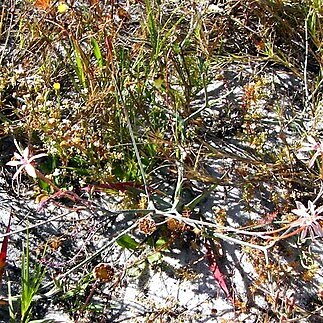Plants 100-300 mm high. Corm bell-shaped, red-brown, 8-10 mm diam.; tunics lightly ridged, rim bluntly lobed. Stem usually repeatedly divaricately branched, compressed and elliptic in cross section, 2-or 3-angled, angles slightly winged, wings weakly serrated. Leaves 5 to 7, lowermost usually longer and wider than others, (40-)80-200 x 3-15 mm, ascending to falcate, lanceolate, ribbed, remaining leaves shorter, mostly crowded near base, becoming increasingly bract-like above. Inflorescences (2)4-to 8-flowered spikes, at first 2-ranked, ultimately spiral; outer bracts grey-green, (5-)6-10 mm long, apices and margins often tinged red, channelled, folded along upper midline, acute in profile; inner 3-5 mm long, transparent with two green keels. Flowers zygomorphic, white to beige or faintly flushed pink, reverse of tepals and tube pink, lower 3 tepals each with red mark in lower midline, and usually with small, claw-like cusp near base; perianth tube narrow and cylindric, weakly arched distally, (20-)40-80 mm long (3-6 times as long as tepals); tepals narrowly lanceolate to ± linear, acute, dorsal largest, 12-14 x 4-5 mm, erect or recurved when fully open, upper lateral 12-14 x ± 3 mm, widely separated from dorsal, lower tepals united basally for 2-3 mm, free parts 12-14 mm long, extended horizontally. Stamens unilateral, ± erect; filaments ± 6 mm long, exserted ± 4 mm from tube; anthers parallel, ± 2.5 mm long; pollen grey-blue or white. Style arching adaxial to anthers, dividing between base and middle of anthers; branches 2-3 mm long, divided for 1/2 their length and recurved. Capsules ± barrel-shaped, 9-10 x ± 7 mm. Seeds red-brown, globose, smooth, somewhat flattened at chalazal end, ± 1.5 mm diam.
More
Cormous geophyte, 100-300 mm tall, stem branching above ground, corm tunics brown, margins scalloped. Leaves linear, ribbed. Flowers several per spike, cream to pink with red markings on lower tepals, perianth tube elongate-cylindrical, tepals narrow, spreading, bracts fairly short.
A corm or bulb plant. It grows 10-30 cm tall. The stem branches above the ground. The corm has a brown coating. The leaves are narrow and ribbed. There are several flowers in each spike. They are cream to pink with red marks.
Cormous geophyte, 10-30 cm. Leaf blades ribbed. Flowers in short spikes, cream-coloured to pink with red markings on lower tepals, tube elongate.

